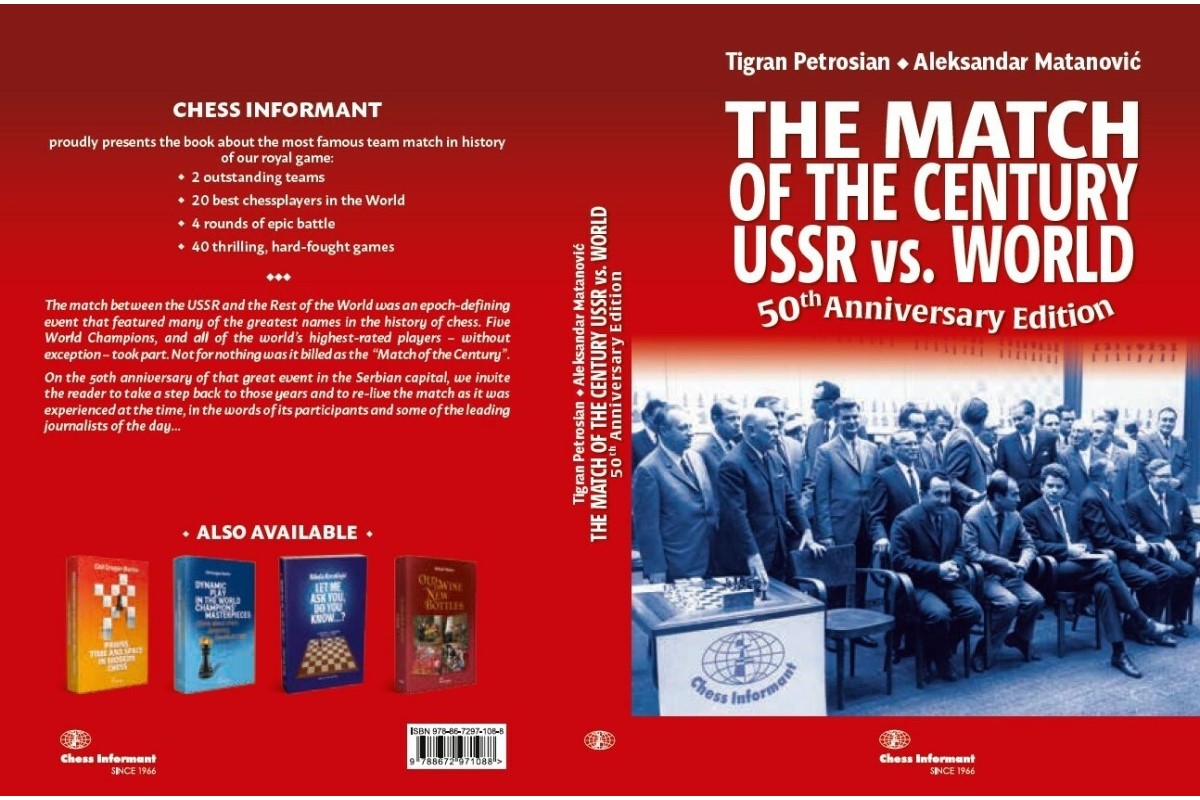A review
When players reveal their thoughts about their moves in a chess game, it is very enjoyable and instructive. Now, imagine if the players were some of the greatest chess legends — giving the reasons behind their moves. As in the following example:
Robert Fischer – Tigran V. Petrosian [B 13]
1.e4 c6 2. d4 d5 3. ed5 cd5 4. Bd3
Fischer: An old variation to get off the beaten track. More usual is 4. c4.
4... Nc6 5. c3 Nf6 6. Bf4
Fischer: If 6. h3 e5. Or 6.Bg5 Ne4 7. Be4 de4 8. d5 Ne5 9. Qa4 Qd7 10. Qe4 Qf5 Black regains the pawn with advantage.
6... Bg4
Fischer: Another possibility is 6... g6.
Petrosian: In recent times Fischer has on several occasions employed this old system of development, which is not considered to be dangerous for Black. Interestingly, in the year 1946 I had to defend with Black in this system in a match for the title of Champion of Armenia, against the experienced master Kasparian...
7. Qb3 Na5
Fischer: Better is Hort’s 7... Qc8 with the idea of ...Bh5 and ...Bg6.
Petrosian: When I was 17 years old, Black’s whole manoeuvre — ...Na5, ...Bd7 — did not appeal to me, and I preferred to play 7... Qb6. I think that I was correct. Also good is 7...Qc8, as Hort has played.
8. Qa4 Bd7 9. Qc2 e6
Fischer: Petrosian suggests 9... a6.
10. Nf3 Qb6
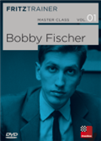 No other World Champion was more infamous both inside and outside the chess world than Bobby Fischer. On this DVD, a team of experts shows you the winning techniques and strategies employed by the 11th World Champion.
No other World Champion was more infamous both inside and outside the chess world than Bobby Fischer. On this DVD, a team of experts shows you the winning techniques and strategies employed by the 11th World Champion.
Grandmaster Dorian Rogozenco delves into Fischer’s openings, and retraces the development of his repertoire. What variations did Fischer play, and what sources did he use to arm himself against the best Soviet players? Mihail Marin explains Fischer’s particular style and his special strategic talent in annotated games against Spassky, Taimanov and other greats. Karsten Müller is not just a leading international endgame expert, but also a true Fischer connoisseur.
11. a4
Fischer: (!) To prevent 11... Bb5 exchanging the ‘problem bishop’. This move refutes Black’s opening strategy and gives White a clear advantage.
Petrosian: Practically forced, since after the exchange of light squared bishops with ...Bb5, Black has an easy game. The invasion at b3 promises Black nothing.
11... Rc8
Fischer: If 11... Nb3 12. Ra2 Rc8 13. 0–0 Be7 White has a harder time making progress, but Black's bishops are still hemmed in. If 11... Qb3 12. Qe2! Ba4? 13. Ra4 Qa4 14. Bb5.
12. Nbd2 Nc6
Petrosian: Seemingly, Black has made a concession. In fact, however, he is entering the path of carrying out a lengthy plan which, alas, is not destined to be realisable.
13. Qb1 Nh5
Fischer: Time consuming. 13... g6 is safer.
14. Be3 h6
Fischer: 14... f5 is smashed by 15. g4! fg4 16. Ng5 Bd6 17. Bh7 etc.
Petrosian: After the game it was unanimously stated that better was 14... g6, but I was attracted by a different idea.
15. Ne5
15... Nf6
Fischer: If 15... Ne5 16. de5 Bc5 17. a5 Qc7 18. Nf3 with a bind.
Petrosian: This is, in fact, effective capitulation. When I played 11... Rc8, I intended in this position 15... Ne5 16. de5 Bc5 and after the exchange of bishops the invasion of the knight at f4, in combination with the move ...f7-f6 and the possibility of ...d5-d4, gives Black a good game. What then is the problem? The point is that only at the very last moment I saw that the intermediate move 17. a5! destroys all Black's plans, since on 17... Qc7 there follows 18. g4 winning a piece, for which after 18... Be3 19. fe3 Qe5 20. gh5 Qe3 21. Be2 Bb5 22. Qd1, with the manoeuvre Nd2-f1-g3, Black has no real compensation.
16. h3
Fischer: To prevent a later ...Ng4 in many variations, and maybe to play g2-g4 after Black castles.
16... Bd6 17. 0–0 Kf8
Fischer: (?) 17... 0–0 is better.
Petrosian: Also after castling Black remains in a difficult situation. After, for example, 18. f4, I did not see how it was possible to oppose the plan of attack with the move g2-g4.
18. f4 Be8
Fischer: If 18... Ne5 19. fe5 Be5 20. a5 wins.
19. Bf2
Fischer: (!)
19... Qc7
Fischer: If 19... g6 20. f5! gf5 21. Bf5 ef5 22. Qf5 Qd8 23. Bh4 wins.
20. Bh4 Ng8
Fischer: Black has a very passive position and hopes to regroup his forces.
21. f5 Ne5 22. de5 Be5 23. fe6 Bf6 24. ef7 Bf7 25. Nf3
Fischer: (!)
Petrosian: White brings up the reserves and it is clear that, without counter play and without co-ordinated piece action, Black cannot hold on for long.
25... Bh4
Fischer: If 25... g5 26. Bf2 Kg7 27. Bd4 etc.
26. Nh4 Nf6 27. Ng6 Bg6 28. Bg6
28... Ke7
Fischer: (!!) Petrosian finds an ingenious defence in a difficult predicament, trying to bring his king to safety on the queen-side. I was almost expecting him to resign instead.
Petrosian: Black’s only chance. Along the dark squares, the king sees if it can find shelter on the queen’s flank.
29. Qf5 Kd8 30. Rae1 Qc5 31. Kh1 Rf8
Fischer: Losing by force. 31... Rc6 holds out longer.
Petrosian: Somewhat better was 31... Rc6, in order in reply to the move 32. Qe5 to have the possibility of 32... Qd6. Instead now there follows a forced finale.
32. Qe5
Fischer: (!) Black is now virtually in zugzwang. The king is cut off from c7.
Petrosian: (!)
32... Rc7
Fischer: 32... Qc7 loses to 33. Rf6! or 33. Qd5!, and wins.
33. b4
Fischer: (!)
33... Qc6
34. c4 34... dc4 35. Bf5 Rff7 36. Rd1 Rfd7
Fischer & Petrosian: If 36... Nd7, then 37. Rfe1 wins.
37. Bd7 Rd7 38. Qb8 Ke7
Fischer: Or 38... Qc8 39. Rd7 Nd7 40. Qd6 and wins.
39. Rde1 1 : 0
Fischer: Because if 39... Kf7 40. Qe8# mate
This is an excerpt from the book The Match of the Century – USSR vs World. In it, all games, played over four rounds on ten boards, are annotated by the players themselves, round-by- round, board-by-board. And the players are… Spassky, Petrosian, Korchnoi, Polugaevsky, Geller, Smyslov, Taimanov, Botvinnik, Tal, Keres, Stein (reserve) and Bronstein (reserve) playing for the USSR, and Larsen, Fischer, Portisch, Hort, Gligorić, Reshevsky, Uhlmann, Matulović, Najdorf , Ivkov, Ólafsson (reserve) and Darga (reserve) playing for the Rest of the World.

The players’ signatures
The match was played half a century ago, in 1970, in Belgrade, the capital of the Socialist Federative Republic of Yugoslavia. Such a match could fit in those times, when Russians were a force to reckon with. In their squad there were five ex-world champions and the then reining one, Spassky. The participants from the ‘rest of the world’ were exactly that, scattered exceptional players coming from various countries in the world — their merit was to be the world’s highest rated players.
Immediately after the end of the match, Aleksandar Matanovic and Tigran Petrosian compiled a book consisting of all the games annotated by the players themselves.
Last year was the fiftieth anniversary since its publication, and a new edition was published, revised and completed with additional information by chess historian Douglas Griffin and Igor Žveglić, the Chess Informant’s commissioning editor. The publisher, then and now, is the Chess Informant.
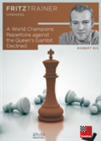 This DVD offers a complete repertoire for handling this solid opening, often featuring a dynamic approach to pose the opponent more practical problems. Both of the main continuations 3...Nf6 and 3...Be7 are covered in two separate parts.
This DVD offers a complete repertoire for handling this solid opening, often featuring a dynamic approach to pose the opponent more practical problems. Both of the main continuations 3...Nf6 and 3...Be7 are covered in two separate parts.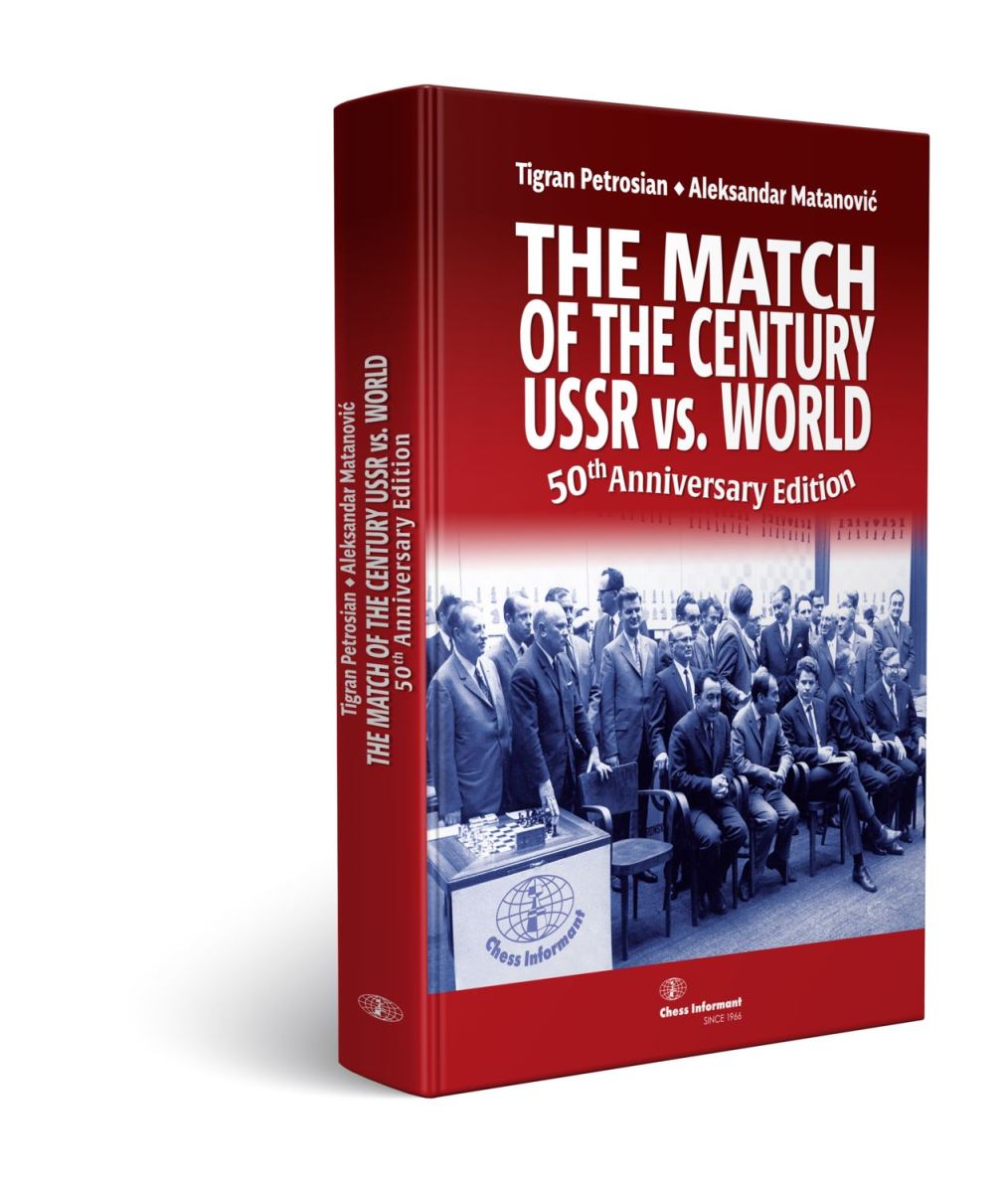
As the editors state in their foreword, “It is unlikely that the game of chess will ever regain the status that it once enjoyed in the Soviet Union and its satellite countries, as well as in Yugoslavia. Truly, it is difficult to imagine the scene that took place in central Belgrade occurring in any city of the world today”.
The interest in this match has not abated after all these years, understandably so considering the number of legends that took part. This book beautifully relives the match before the eyes and mind of the reader. The first eighty pages include a historic background to the making of the match, a collection of journalistic write-ups of the time surrounding the event wihch are complemented by interviews, recollections and opinions given by the participants and observers and a detailed description of the scene and happenings before, during and after the event. A large section is dedicated to profiles of the players, board-by-board, their score up to the match and a selection of their most significant encounters.
After the key section of the book, the annotated games, a Reaction to the Match in the Soviet Press clearly shows the lukewarm reception that the Russians received in their country after an ‘insignificant’ 20½:19½ win. After such an ‘abysmal’ victory by a mere 1-point difference, the Russian grandmasters received a modest gift upon their arrival at the airport: each of them was handed a single red carnation, according to a press article in the notable Russian chess magazine ‘64’.

Petrosian v Fischer with Gligoric looking on
The historical bits and trivia include Fischer’s well-known antics about his many demands and conditions, which are described in detail. We are given the full content of the many telegrams that were frantically flying between him and the organizers, who were at the end of their wits trying to satisfy him while keeping the starting time as planned.
A great point of interest to us — but a headache to the organizers — was the rivalry between Fischer and Larsen about who would play on the first board for the Rest of the World team, each of them claiming a supremacy over the other and conditioning their participation on the issue. It came to Max Euwe, the captain of the World team, to make a decision, but I’d rather not divulge here all the intricacies apart from the final solution that was rather amusing: after it has been announced and agreed that Fischer would play on the first board, in the last minute, before the start of the first round, the decision was reverted and on the first board sat Larsen. All of this is meticulously described in the many articles that the authors had carefully gathered to bring us this unforgettable event in a most vivid form.
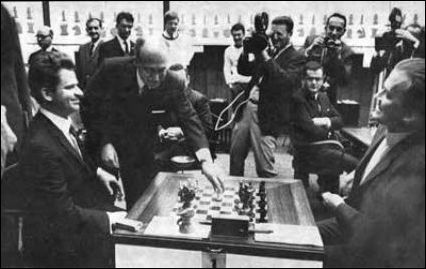
Mitja Ribičič, the president of the Yugoslav Federal Executive Council makes the first move
But, of course, the games are the main attraction, annotated by the players themselves, with several diagrams per game. The reader can follow each game from the point of view of both opponents.
As a teaser I chose two games of which I am presenting only the first ten moves: Tal v Najdorf, from the first round, and Korchnoi v Portish, from the third round. Tal was allocated only the ninth board out of ten, and he played against Najdorf, the oldest player at the tournament.
Board 9: Mikhail Tal – Miguel Najdorf [B 48]
1.e4 c5 2. Nf3 Nc6 3. d4 cd4 4. Nd4 e6
Tal: The old love of the Argentinean grand master — the system with 2... d6 and 5... a6 — has been replaced with a new. In recent times Najdorf has played the Paulsen Variation often, enthusiastically and with success.
5. Nc3 Qc7 6. Be3 a6 7. Bd3 Nf6 8. 0–0 Ne5
Tal: The plan chosen by White is very popular. Now, in this position, 8... d4 9. Bd4 Bc5; and 8... b5 are also encountered.
Najdorf: Up to this moment the game proceeds along well known lines.
9. h3
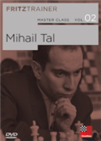 On this DVD Dorian Rogozenco, Mihail Marin, Oliver Reeh and Karsten Müller present the 8. World Chess Champion in video lessons: his openings, his understanding of chess strategy, his artful endgame play, and finally his immortal combinations.
On this DVD Dorian Rogozenco, Mihail Marin, Oliver Reeh and Karsten Müller present the 8. World Chess Champion in video lessons: his openings, his understanding of chess strategy, his artful endgame play, and finally his immortal combinations.
Tal: Deserving attention is 9. Be2, leaving, in a number of cases, the square h3 free for the queen, which could from there display noticeable activity on the queen's flank. The move 9. Be2 was tested in a series of games at Palma de Mallorca (1969), although the first conclusions have still to be drawn. For the time being White does not depart from the beaten path.
Najdorf: In the game against Penrose (Palma de Mallorca, 1969), on 9. Be2 I played 9... b5 10. f4 Nc4 11. Bc4 Qc4 12. e5 Nd5 13. Nd5 Qd5 with good prospects for Black.
9... Bc5
Tal: This continuation gained popularity after the 23rd game of the World Championship match, when Petrosian employed it against Spassky. In general, it seems, it has been studied by Leningrad chess players.
10. Kh1
Tal: (?) Coming to the game, I intended to continue here 10. Na4 Ba7 11. c4!?, and the capture of the pawn is fatal: 11... Nc4 12. Bc4 Qc4 13. Rc1 Qb4 14. Ne6!. At the board, however, I changed my mind, and began to test a continuation rejected by theory, 10. f4?? Nc6 11. Nf5 Qb6 12. Nd6 Kf8 13. Bc5 Qc5 14. Kh1 Qd6 15. e5, and then decided that in the first round — which is, as a rule, an unlucky one for me — such a gambit would not do, and I instead played a meaningless move. Stronger is 10. Qe2, as Spassky played in the above mentioned game.
[...] ½ :½
I found interesting the exchange of thoughts in the game Korchnoi v Portisch, in the third round, in which both players emphasize the fact that, at the beginning of the game, Korchnoi was kibitzing at the other boards and, as a result, forgot a key move in the opening phase, thus providing Portisch with an easy middlegame, which he ultimately converted in a win.
Board 3: Viktor Korchnoi – Lajos Portisch [C 90]
1.e4 e5 2. Nf3 Nc6 3. Bb5 a6 4. Ba4 Nf6 5. 0–0 Be7 6. Re1 b5 7. Bb3 d6
8. h3
Korchnoi: (?) Having been watching the game Geller - Gligorić, I forgot about my ‘Spanish’ bishop.
Portisch: (?) This move is a fingerfehler. Korchnoi, who was watching the opening of the other games, automatically moved the pawn, forgetting that he had not yet played c2-c3.
8... Na5
Korchnoi: Now Black has easy play and every chance of achieving an advantage in the middlegame.
9. Nc3 0–0 10. d3
Portisch: In a closed position the lack of the ‘Spanish’ bishop is not so important, so it is easy to understand why Korchnoi chose this move.
10... Re8 11. Bg5
Korchnoi: The only thing of which White can dream is to exchange as many pieces as possible, and in particular, one of the black bishops, for example 11... Bb7 12. Bf6! Bf6 13. Nd5. However, even after White having achieved this possibility, Black would have retained the advantage — he still has the strong light squared bishop.
[...] 0 – 1

Amicable conversation: Ivkov, Gligorić, Spassky, Keres and Najdorf
You may wish to ditch the internet for a moment, dust your board and pieces and, in the old-fashioned way, immerse and delight in fascinating games played half a century ago — all of them timeless in their significance and mastery. The revised edition has ignited a great interest even after all this time. The Informant’s manager Vitomir Bozic told me that “it has been selling like hot cakes”. A highly satisfying treat, indeed.
[All photos reproduced from the book]
Considered a master of prophylaxis, Petrosian sensed dangers long before they actually became acute on the board. In his prime, Petrosian was almost invincible. Let our authors introduce you into the world of Tigran Petrosian.
Links
